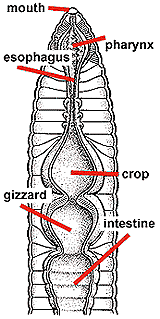Earthworm
Earthworms Help The Environment
Earthworms are more than just fish bait. They are the main contributors to enriching and improving soil for plants, animals and even humans. Earthworms create tunnels in the soil by burrowing, which aerates the soil to allow air, water and nutrients to reach deep within the soil. Earthworms eat the soil which has organic matter such as decaying vegetation or leaves. Plants cannot use this organic matter directly. After organic matter is digested, the earthworm releases waste from their bodies called castings. Castings contain many nutrients that the plant can use. Some people even use earthworm castings as garden fertilizer.
Earthworm AnatomyEarthworms are classified in the phylum Annelida or Annelids. Annelida in Latin means, “little rings.” The body of the earthworm is segmented which looks like many little rings joined or fused together. The earthworm is made of about 100-150 segments. The segmented body parts provide important structural functions. Segmentation can help the earthworm move. Each segment or section has muscles and bristles called setae.
Digestive System
The digestive system is partitioned into many regions, each with a certain function. The digestive system consists of the pharynx, the esophagus, the crop, the intestine and the gizzard. Food such as soil enters the earthworm’s mouth where it is swallowed by the pharynx. Then the soil passes through the esophagus, which has calciferous glands that release calcium carbonate to rid the earthworm’s body of excess calcium. After it passes through the esophagus, the food moves into the crop where it is stored and then eventually moves into the gizzard. The gizzard uses stones that the earthworm eats to grind the food completely. The food moves into the intestines as gland cells in the intestine release fluids to aid in the digestive process. The intestinal wall contains blood vessels where the digested food is absorbed and transported to the rest of the body.Earthworm Reproduction
Earthworms are hermaphrodites where each earthworm contains both male and female sex organs. The male and female sex organs can produce sperm and egg respectively in each earthworm. Although earthworms are hermaphrodites, most need a mate to reproduce. During mating, two worms line up inverted from each other so sperm can be exchanged. The earthworms each have two male openings and two sperm receptacles, which take in the sperm from another mate. The earthworms have a pair of ovaries that produce eggs. The clitellum will form a slime tube around it, which will fill with an albuminous fluid. The earthworm will move forward out of the slime tube. As the earthworm passes through the slime tube, the tube will pass over the female pore picking up eggs. The tube will continue to move down the earthworm and pass over the male pore called the spermatheca which has the stored sperm called the spermatozoa. The eggs will fertilize and the slime tube will close off as the worm moves completely out of the tube. The slime tube will form an “egg cocoon” and be put into the soil. The fertilized eggs will develop and become young worms.



UJAS
ОтговорИзтриване